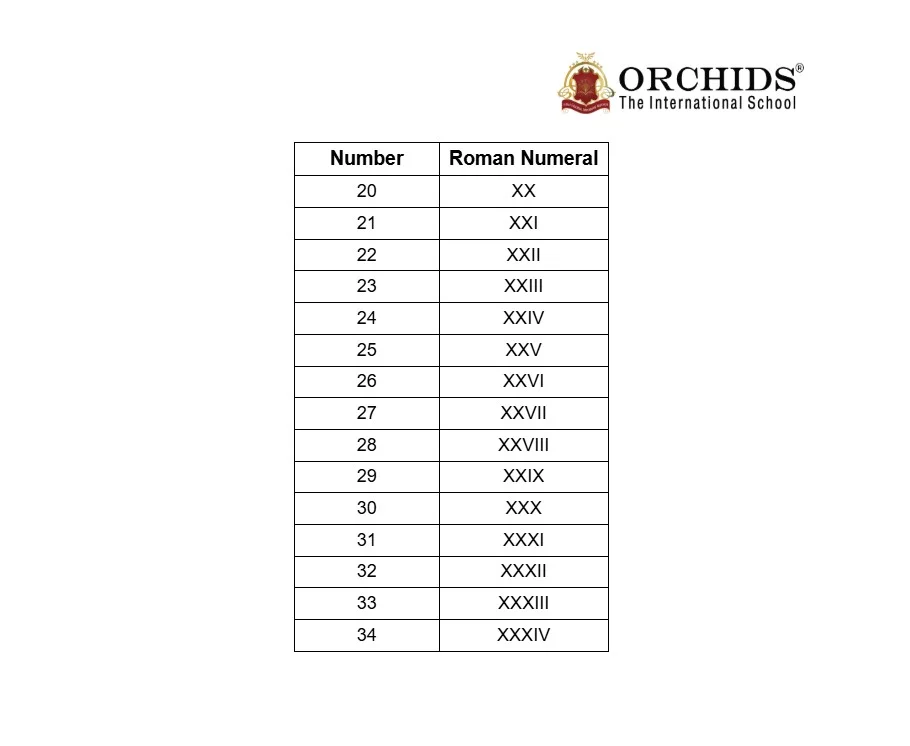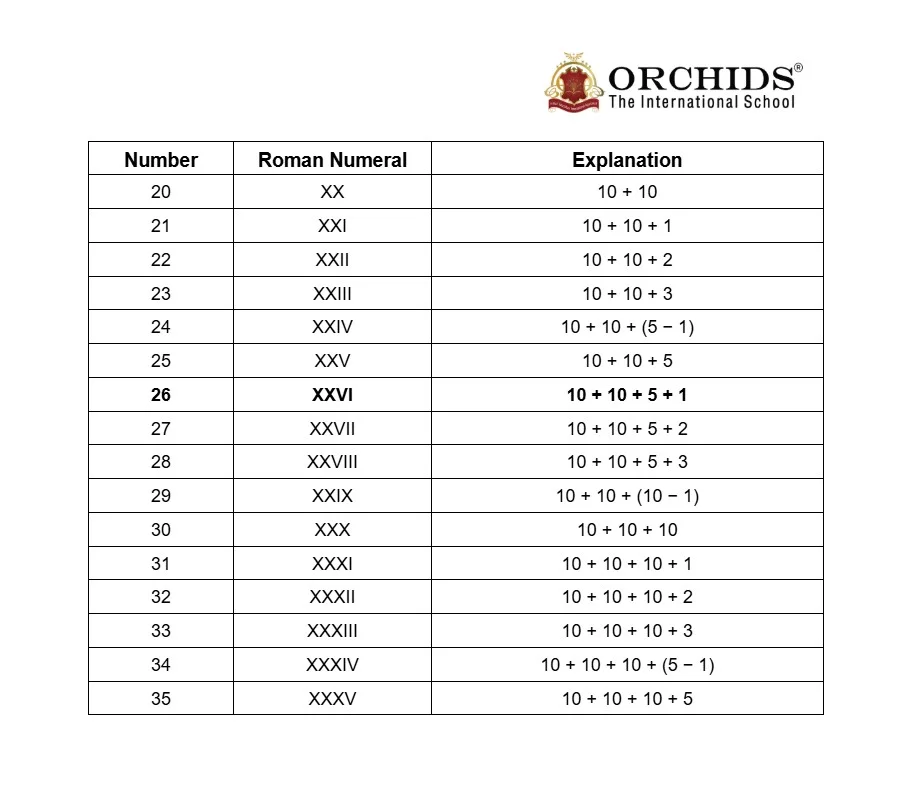26 in Roman Numerals
26 in Roman numerals is written as XXVI, an ancient way of showing numbers used by the Romans. This numeral form uses letters to represent values, where X means 10 and I means 1. Understanding how to read and write numbers in Roman numerals helps students connect mathematics. It also improves logical thinking by teaching them how values are combined to form larger numbers. The study of XXI is not only a mathematical skill but also a link to the past, which makes number study more interesting and meaningful in everyday life.
Table of Contents
- How to Write 26 in Roman Numerals
- Basic Rules to Write 26 in Roman Numerals
- Roman Numerals 26 Conversion Chart
- Roman Numerals 26 Explanation Table
- Solved Examples on Roman Numerals 26
- Facts About 26 in Roman numerals
- Practice Questions
- Conclusion
- FAQs on 26 in Roman Numerals
How to Write 26 in Roman Numerals
To write 26 in Roman numerals, we use the symbols that represent tens and units. The principal Roman numerals symbols are:
Step-by-step:
-
XX = 10 + 10 = 20
-
V = 5
-
I = 1
Add them: 20 + 5 + 1 = 26
Therefore, 26 in Roman numerals is XXVI.
Basic Rules to Write 26 in Roman Numerals
To write 26 in Roman numerals, students should follow these simple rules based on the Roman numeral system:
Know the values:
-
I = 1
-
V = 5
-
X = 10
-
L = 50
-
C = 100
-
D = 500
-
M = 1000
Repeat letters to add values:
-
Letters I, X, and C can be repeated up to three times. For 26, you write two X’s to make 20.
Write numerals in order from largest to smallest:
-
Write the largest numeral first. For 26, write XX (for 20), then V (for 5), followed by I (for 1).
Add the values when smaller or equal numerals follow larger ones:
-
When a smaller symbol follows a larger one, add their values. So, XX (20) + V (5) + I (1) = XXVI (26).
No subtractive rules needed for 26:
-
Since 26 doesn’t require subtraction like IV (4) or IX (9), just add the numeral values.
Therefore, 26 in Roman numerals is XXVI.
Roman Numerals 26 Conversion Chart

Roman Numerals 26 Explanation Table

Solved Examples on Roman Numerals 26
Example 1: A library had 15 storybooks and received 11 more. Find the total number of books and express it in Roman numerals.
Solution:
15 + 11 = 26
Therefore, 26 in Roman numerals is XXVI.
Example 2: Add XV (15) and XI (11). Write the total in Roman numerals.
Solution:
XV = 15, XI = 11
15 + 11 = 26
Therefore, 26 = XXVI.
Example 3: Subtract IV (4) from XXX (30). Express the result in Roman numerals.
Solution:
XXX = 30, IV = 4
30 − 4 = 26
Therefore, 26 in Roman numerals is XXVI.
Example 4: Multiply XIII (13) by II (2). Write the answer in Roman numerals.
Solution:
13 × 2 = 26
Therefore, 26 = XXVI.
Example 5: What is the sum of XIX (19) and VII (7)? Write the result in Roman numerals.
Solution:
19 + 7 = 26
Therefore, 26 = XXVI.
Facts About 26 in Roman Numerals
-
Roman Numeral: 26 is written as XXVI (10 + 10 + 5 + 1).
-
Even Number: 26 is even; its positive divisors are 1, 2, 13, and 26.
-
Decomposition: XX = 20, V = 5, I = 1 → 20 + 5 + 1 = 26.
-
No Subtractive Needed: 26 doesn’t use subtractive forms like IV (4) or IX (9); you just add values.
-
Symbol Count: XXVI uses three types of symbols, X, V, and I (four characters total).
Practice Questions
-
How do you write the number 26 using Roman numerals?
-
What are the Roman numerals for 27, 28, 29, 30?
-
Convert the Roman numeral XXVI into the regular decimal number.
-
Calculate XXVI + I and write your answer in Roman numerals.
-
Add XX and VI together and express the total as a Roman numeral.
Conclusion
In Roman numerals, 26 is written as XXVI by combining two X's (each representing 10), one V (5), and one I (1). This is a simple example that helps students understand how Roman numerals are used similarly to creating numbers. Learning it also makes it easier to read and write different Roman numerals.
FAQs on 26 in Roman Numerals
1. What does 26 in Roman Numerals mean?
The number 26 in Roman numerals is written as XXVI, which represents a combination of Roman symbols that together make up the value 26. Roman numerals use specific letters to denote values, and these are added or subtracted to form numbers.
2. How to Convert 26 into Roman Numerals?
To convert 26 into Roman numerals, break it down by place value using the Roman numeral system:
-
20 = XX
-
6 = VI
Now, add them together:
20 (XX) + 6 (VI) = XXVI
So, 26 = XXVI.
3. What does XXVI mean?
The Roman numeral XXVI means the number 26. It is formed by combining symbols where “XX” represents 20 and “VI” represents 6. When placed together, they total 26.
4. What are the individual symbols?
Here’s the breakdown of XXVI:
-
X = 10
-
X = 10
-
V = 5
-
I = 1
Add them together:
10 + 10 + 5 + 1 = 26
At Orchids The International School, we make learning simple and engaging. Explore more Maths concepts, Roman numeral lessons, and fun practice for every grade.
Related Links
Admissions Open for
Admissions Open for
CBSE Schools In Popular Cities
- CBSE Schools in Bangalore
- CBSE Schools in Mumbai
- CBSE Schools in Pune
- CBSE Schools in Hyderabad
- CBSE Schools in Chennai
- CBSE Schools in Gurgaon
- CBSE Schools in Kolkata
- CBSE Schools in Indore
- CBSE Schools in Sonipat
- CBSE Schools in Delhi
- CBSE Schools in Rohtak
- CBSE Schools in Bhopal
- CBSE Schools in Aurangabad
- CBSE Schools in Jabalpur
- CBSE Schools in Jaipur
- CBSE Schools in Jodhpur
- CBSE Schools in Nagpur
- CBSE Schools in Ahmednagar
- CBSE School In Tumkur











